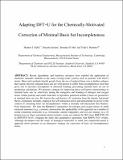Adapting DFT+U for the Chemically Motivated Correction of Minimal Basis Set Incompleteness
Author(s)
Mar, Brendan D.; Martinez, Todd J.; Kulik, Heather Janine; Seelam, Natasha
Downloadmanuscript_in_pdf.pdf (7.361Mb)
PUBLISHER_POLICY
Publisher Policy
Article is made available in accordance with the publisher's policy and may be subject to US copyright law. Please refer to the publisher's site for terms of use.
Terms of use
Metadata
Show full item recordAbstract
Recent algorithmic and hardware advances have enabled the application of electronic structure methods to the study of large-scale systems such as proteins with O(103) atoms. Most such methods benefit greatly from the use of reduced basis sets to further enhance their speed, but truly minimal basis sets are well-known to suffer from incompleteness error that gives rise to incorrect descriptions of chemical bonding, preventing minimal basis set use in production calculations. We present a strategy for improving these well-known shortcomings in minimal basis sets by selectively tuning the energetics and bonding of nitrogen and oxygen atoms within proteins and small molecules to reproduce polarized double-ζ basis set geometries at minimal basis set cost. We borrow the well-known +U correction from the density functional theory community normally employed for self-interaction errors and demonstrate its power in the context of correcting basis set incompleteness within a formally self-interaction-free Hartree–Fock framework. We tune the Hubbard U parameters for nitrogen and oxygen atoms on small-molecule tautomers (e.g., cytosine), demonstrate the applicability of the approach on a number of amide-containing molecules (e.g., formamide, alanine tripeptide), and test our strategy on a 10 protein test set where anomalous proton transfer events are reduced by 90% from RHF/STO-3G to RHF/STO-3G+U, bringing the latter into quantitative agreement with RHF/6-31G* results. Although developed with the study of biological molecules in mind, this empirically tuned U approach shows promise as an alternative strategy for correction of basis set incompleteness errors.
Date issued
2016-07Department
Massachusetts Institute of Technology. Department of Chemical EngineeringJournal
The Journal of Physical Chemistry A
Publisher
American Chemical Society
Citation
Kulik, Heather J., Natasha Seelam, Brendan D. Mar, and Todd J. Martínez. “Adapting DFT+Ufor the Chemically Motivated Correction of Minimal Basis Set Incompleteness.” The Journal of Physical Chemistry A 120, no. 29 (July 28, 2016): 5939–5949.
Version: Author's final manuscript
ISSN
1089-5639
1520-5215